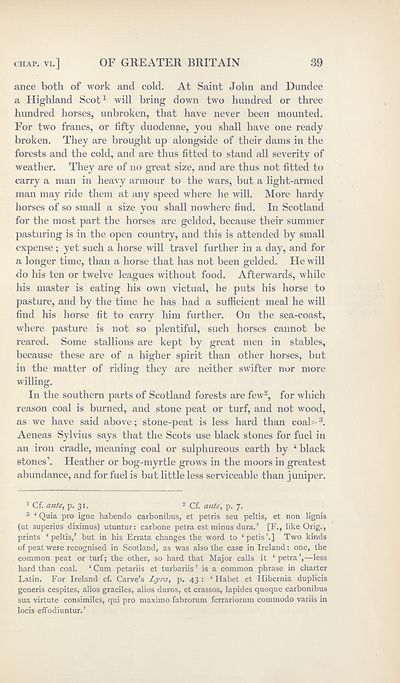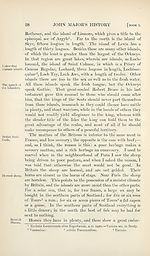Series 1 > History of Greater Britain, as well England as Scotland
(184) Page 39
Download files
Complete book:
Individual page:
Thumbnail gallery: Grid view | List view

CHAP. VI.]
OF GREATER BRITAIN
39
ance both of work and cold. At Saint John and Dundee
a Highland Scot1 will bring down two hundred or three
hundred horses, unbroken, that have never been mounted.
For two francs, or fifty duodenae, you shall have one ready
broken. They are brought up alongside of their dams in the
forests and the cold, and are thus fitted to stand all severity of
weather. They are of no great size, and are thus not fitted to
carry a man in heavy armour to the wars, but a light-armed
man may ride them at any speed where he will. More hardy
horses of so small a size you shall nowhere find. In Scotland
for the most part the horses are gelded, because their summer
pasturing is in the open country, and this is attended by small
expense; yet such a horse will travel further in a day, and for
a longer time, than a horse that has not been gelded. He will
do his ten or twelve leagues without food. Afterwards, while
his master is eating his own victual, he puts his horse to
pasture, and by the time he has had a sufficient meal he will
find his horse fit to carry him further. On the sea-coast,
where pasture is not so plentiful, such horses cannot be
reared. Some stallions are kept by great men in stables,
because these are of a higher spirit than other horses, but
in the matter of riding they are neither swifter nor more
willing.
In the southern parts of Scotland forests are few2, for which
reason coal is burned, and stone peat or turf, and not wood,
as we have said above; stone-peat is less hard than coal>3.
Aeneas Sylvius says that the Scots use black stones for fuel in
an iron cradle, meaning coal or sulphureous earth by 4 black
stones’. Heather or bog-myrtle grows in the moors in greatest
abundance, and for fuel is but little less serviceable than juniper.
1 Cf. ante, p. 31. 3 Cf. ante, p. 7.
3 ‘ Quia pro igne habendo carbonibus, et petris seu peltis, et non lignis
(ut superius diximus) utuntur: carbone petra est minus dura.’ [F., like Orig.,
prints ‘peltis,’ but in his Errata changes the word to ‘petis’.] Two kinds
of peat were recognised in Scotland, as was also the case in Ireland: one, the
common peat or turf; the other, so hard that Major calls it ‘petra’,—less
hard than coal. ‘ Cum petariis et turbariis ’ is a common phrase in charter
Latin. For Ireland cf. Curve’s Lyra, p. 43 : ‘ Habet et Hibernia duplicis
generis cespites, alios graciles, alios duros, et crassos, lapides quoque carbonibus
sua virtute consimiles, qui pro maximo fabrorum ferrariorum commodo variis in
locis effodiuntur.’
OF GREATER BRITAIN
39
ance both of work and cold. At Saint John and Dundee
a Highland Scot1 will bring down two hundred or three
hundred horses, unbroken, that have never been mounted.
For two francs, or fifty duodenae, you shall have one ready
broken. They are brought up alongside of their dams in the
forests and the cold, and are thus fitted to stand all severity of
weather. They are of no great size, and are thus not fitted to
carry a man in heavy armour to the wars, but a light-armed
man may ride them at any speed where he will. More hardy
horses of so small a size you shall nowhere find. In Scotland
for the most part the horses are gelded, because their summer
pasturing is in the open country, and this is attended by small
expense; yet such a horse will travel further in a day, and for
a longer time, than a horse that has not been gelded. He will
do his ten or twelve leagues without food. Afterwards, while
his master is eating his own victual, he puts his horse to
pasture, and by the time he has had a sufficient meal he will
find his horse fit to carry him further. On the sea-coast,
where pasture is not so plentiful, such horses cannot be
reared. Some stallions are kept by great men in stables,
because these are of a higher spirit than other horses, but
in the matter of riding they are neither swifter nor more
willing.
In the southern parts of Scotland forests are few2, for which
reason coal is burned, and stone peat or turf, and not wood,
as we have said above; stone-peat is less hard than coal>3.
Aeneas Sylvius says that the Scots use black stones for fuel in
an iron cradle, meaning coal or sulphureous earth by 4 black
stones’. Heather or bog-myrtle grows in the moors in greatest
abundance, and for fuel is but little less serviceable than juniper.
1 Cf. ante, p. 31. 3 Cf. ante, p. 7.
3 ‘ Quia pro igne habendo carbonibus, et petris seu peltis, et non lignis
(ut superius diximus) utuntur: carbone petra est minus dura.’ [F., like Orig.,
prints ‘peltis,’ but in his Errata changes the word to ‘petis’.] Two kinds
of peat were recognised in Scotland, as was also the case in Ireland: one, the
common peat or turf; the other, so hard that Major calls it ‘petra’,—less
hard than coal. ‘ Cum petariis et turbariis ’ is a common phrase in charter
Latin. For Ireland cf. Curve’s Lyra, p. 43 : ‘ Habet et Hibernia duplicis
generis cespites, alios graciles, alios duros, et crassos, lapides quoque carbonibus
sua virtute consimiles, qui pro maximo fabrorum ferrariorum commodo variis in
locis effodiuntur.’
Set display mode to:
![]() Universal Viewer |
Universal Viewer | ![]() Mirador |
Large image | Transcription
Mirador |
Large image | Transcription
Images and transcriptions on this page, including medium image downloads, may be used under the Creative Commons Attribution 4.0 International Licence unless otherwise stated. ![]()
| Scottish History Society volumes > Series 1 > History of Greater Britain, as well England as Scotland > (184) Page 39 |
|---|
| Permanent URL | https://digital.nls.uk/127733973 |
|---|
| Attribution and copyright: |
|
|---|
| Description | Over 180 volumes, published by the Scottish History Society, containing original sources on Scotland's history and people. With a wide range of subjects, the books collectively cover all periods from the 12th to 20th centuries, and reflect changing trends in Scottish history. Sources are accompanied by scholarly interpretation, references and bibliographies. Volumes are usually published annually, and more digitised volumes will be added as they become available. |
|---|


